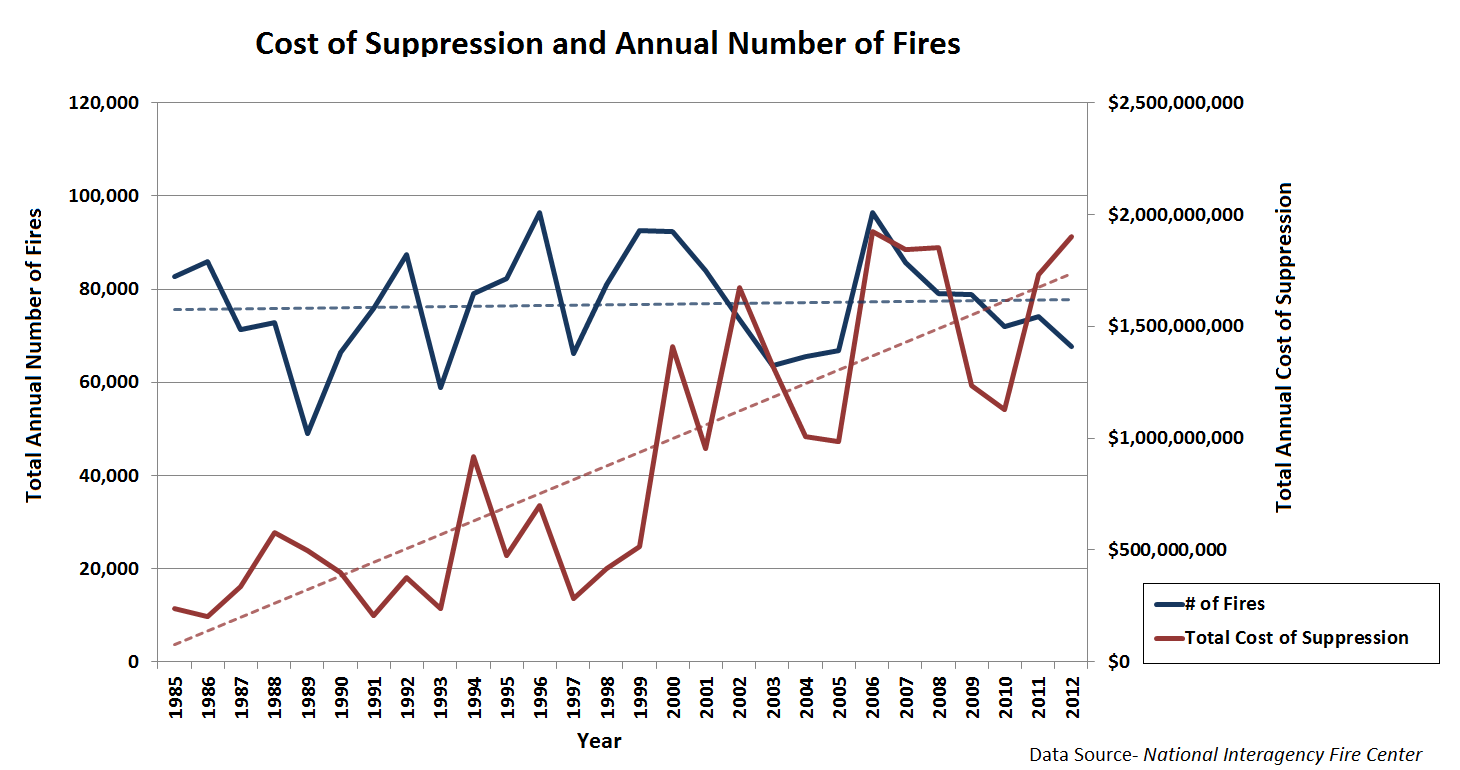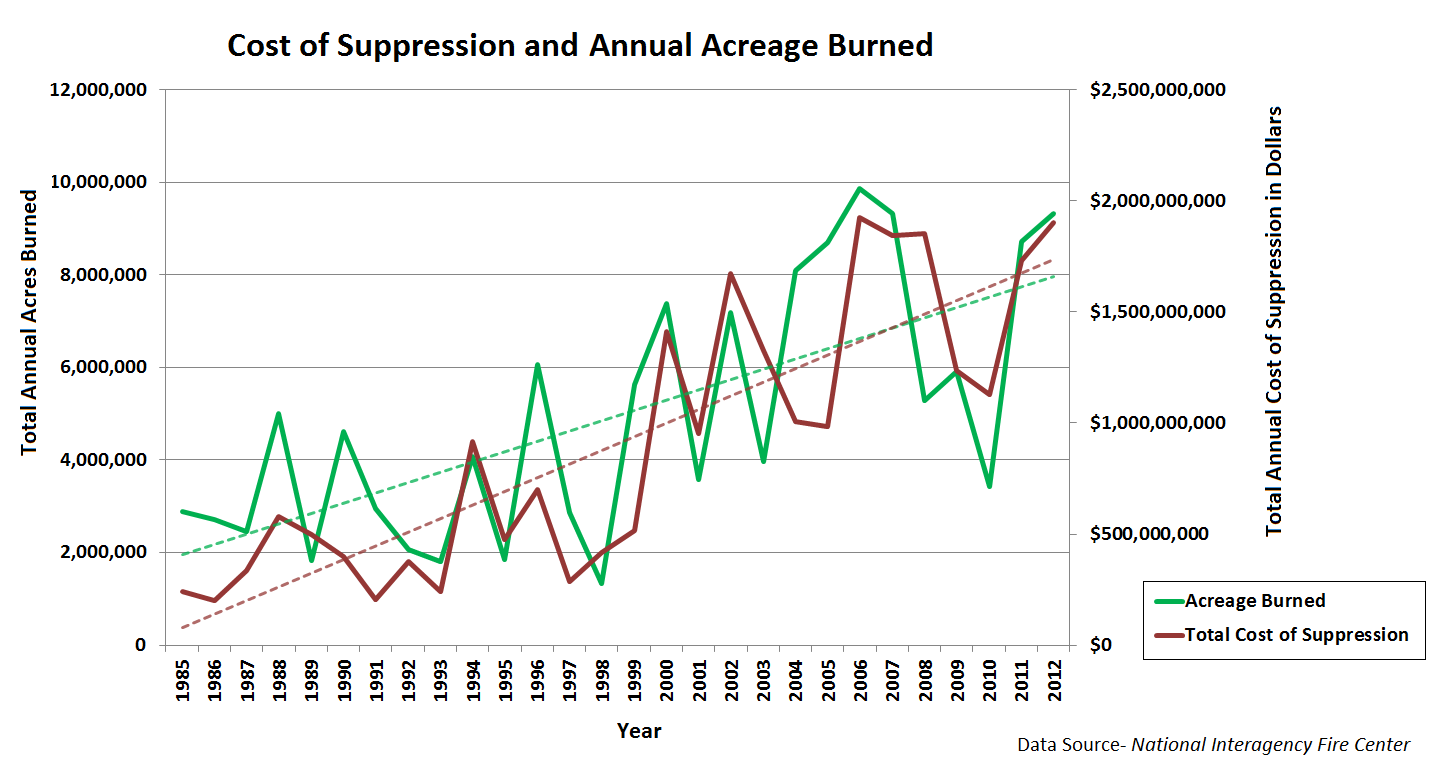Forest Fire Update and the Cost of Suppression
August 23, 2013
BY Kolby Hoagland
Recent media coverage on the number and size of wildfires currently aflame in the Western U.S. has intensified concerns around the financial burden placed on the agencies that fight the blazes and, ultimately, the tax payers that foot the bill. This year’s fire season has already seen 32,733 blazes, scorching more than 3.5 million acres of federal, state, and private land in the U.S.. Based on current and historical trends, by the end of the year an area equal to the size of New Jersey and Massachusetts combined will be ravaged by fire.
Protecting properties, watersheds, air quality, and forest resources from the harms of wildfire is a pricey affair that is only becoming more expensive. Last year was the most costly fire season to date, totaling $1.9 billion that the U.S. Federal Government doled out to state and federal agencies responsible for fighting wildfires. The graphs below look at the correlation of annual cost that the U.S. Federal Government pays for wildfire suppression to the number of fires and the total acreage burned. The similar slopes in the trend lines in the ‘Cost of Suppression and Annual Acreage Burned’ graph gives strength to the argument that the size of the blaze, not the total number of blazes, strongly affects the ultimate cost. There are other factors that affect cost: accessibility, proximity to property, number of aircraft used, etc.; however, the year to year rise or fall in cost of suppression and size of burned area strongly mimic each other. An overwhelming indication in the graph and among experts is that wildfires will affect greater areas each year, and this will incurr greater costs for future wildfire suppression efforts. Larger fires do not bode well for the agencies responsible for protecting forest assets and the tax payers that fund them.
Previous DataPoints Blogs have discussed the benefits of wildfire mitigation strategies that combine forest restoration efforts and bioenergy production by highlighting specific projects. Eagle Valley Clean Energy’s 12 MW combined heat and power plant, currently under construction in Gypsum, CO, is an example of a bioenergy project that assists in protecting threatened communities from the danger of wildfires. By creating a demand for forest restoration residue, the bioenergy plant is reducing the cost of thinning forest by purchasing low value biomass from the foresters that are in the forest removing fuel loads. When there is not a demand for forest thinning residue, forest restoration practices typically collect the thinning material that has little to no value (generally the smaller diameter trees and slash) into piles and burn them during winter months. The burning of slash piles cost money that could be earned by selling the fuel and reduces air quality in the area where the piles are set aflame. Furthermore, a Northern Arizona University paper finds that forest thinning and restoration efforts significantly reduce fire suppression costs even if a wildfire comes through a ‘restored’ area of the forest. A wildfire that does hit an area that has received restoration treatments are more easily contained, allowing fire crews to attack other fires. Incorporating bioenergy production into wildfire prevention strategies is an investment that not only produces clean, renewable energy but also significantly reduces the financial burden of wildfire suppression. If the government would like to reduce suppression costs they should look at preventative strategies that incoroporate bioenergy production from the removed biomass.
Advertisement


Advertisement
Related Stories
The U.S. Department of Energy Bioenergy Technologies Office (BETO) announced up to $23 million in funding to support research and development (R&D) of domestic chemicals and fuels from biomass and waste resources.
The U.S. DOE has announced its intent to issue funding to support high-impact research and development (R&D) projects in two priority areas: sustainable propane and renewable chemicals and algal system cultivation and preprocessing.
Sens. Sherrod Brown, D-Ohio, and Pete Ricketts, R-Neb., in August introduced the Renewable Chemicals Act, a bill that aims to create a tax credit to support the production of biobased chemicals.
The Chemical Catalysis for Bioenergy Consortium, a consortium of the U.S. DOE’s Bioenergy Technologies Office, has launched an effort that aims to gather community input on the development of new biomass processing facilities.
USDA on March 8 celebrated the second annual National Biobased Products Day, a celebration to raise public awareness of biobased products, their benefits and their contributions to the U.S. economy and rural communities.
Upcoming Events










